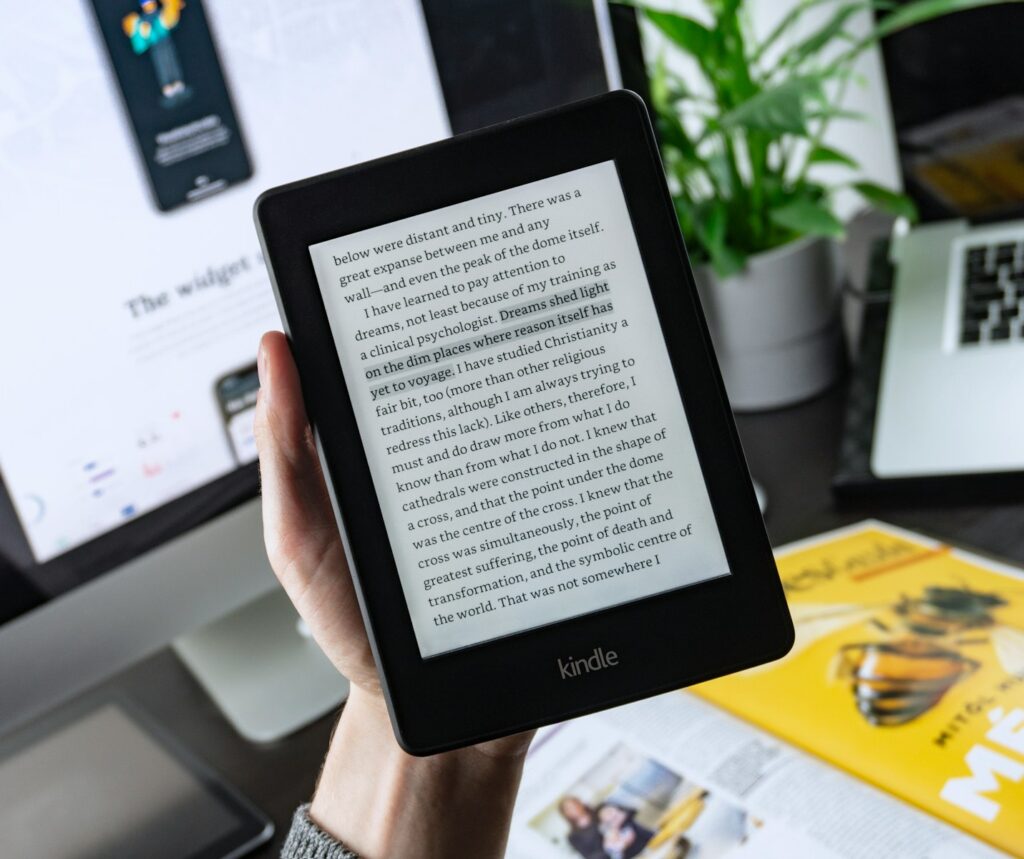The publishing industry has transformed significantly in recent years, offering authors more options than ever before. Among these options, self-publishing platforms like Kindle Direct Publishing (KDP) have gained immense popularity, creating new pathways for aspiring authors to share their work with a global audience. Simultaneously, traditional publishing companies continue to hold their ground, offering expert guidance and resources to help authors refine their craft and grow their readership. Welcome to Kindle Direct Publishing, where you can publish both print and digital books and reach millions of readers globally.
If you’re an aspiring author, particularly if you’re a Christian author with a unique message to share, you may find yourself weighing the benefits of these two publishing approaches. Should you self-publish using Kindle Direct Publishing, or is an actual publishing company the better choice? This guide will break down the pros and cons of both options to help you decide.

Photo by @felipepelaquim on Unsplash
Understanding Kindle Direct Publishing
Amazon’s Kindle Direct Publishing (KDP) is one of the most popular self-publishing platforms. It enables authors to self-publish print and digital books directly to Amazon’s marketplace. With tools to format your manuscript, design a book cover, and even distribute globally, KDP makes the publishing process accessible and straightforward.
What Makes KDP Attractive to Authors?
There are several reasons why aspiring authors are drawn to self-publishing through Kindle Direct:
- Creative Control: Authors retain complete control over every aspect of their book, from cover design to pricing.
- Higher Royalties: KDP allows authors to earn up to 70% royalties for ebooks sold within certain pricing guidelines.
- Global Reach: By publishing on Amazon, your work can reach millions of readers around the world, with distribution across all of Amazon’s marketplaces.
- Quick Turnaround: Upload your manuscript today, and your book could be live within hours.
- KDP KU Author Earnings: Authors can benefit from the KDP Select program, which includes Kindle Unlimited, contributing to significant KDP KU author earnings.
But KDP is not without its challenges.
The Drawbacks of KDP
While self-publishing through KDP offers convenience and accessibility, certain limitations come into play:
- Reliance on Self-Marketing: Most self-published authors are solely responsible for promoting their work. Without an established audience, visibility can be challenging.
- Stigma Surrounding Self-Publishing: Despite its growth, self-publishing still carries a stigma in some literary circles, making it harder to gain acceptance or awards.
- Quality Concerns: Without professional editing, design, or marketing support, some self-published works may fall short of industry standards.

Photo by Balázs Kétyi on Unsplash
The Self-Publishing Process
Self-publishing on Amazon Kindle Direct Publishing (KDP) is a straightforward process that empowers authors to maintain control over their work. To get started, you can sign in to your existing Amazon account or create a new one. Once logged in, you’ll have access to the KDP dashboard, where the journey of publishing your book begins.
The first step involves preparing your book file. Amazon KDP provides a range of tools and resources to assist you, including a comprehensive formatting guide and a cover creator tool. These resources ensure that your manuscript is properly formatted and visually appealing. After your book file is ready, you can upload it to the KDP platform.
Once your book is live, you can track your sales and analytics through the KDP dashboard. This feature allows you to monitor your book’s performance, make necessary adjustments to its details and pricing, and optimize your marketing strategies. With KDP, the power to publish and promote your book is at your fingertips.
Creating a Book Cover and Formatting
Creating a compelling book cover and ensuring proper formatting are crucial steps in the self-publishing process. A well-designed cover can make your book stand out and attract readers, while proper formatting ensures that your book looks professional and is easy to read.
Amazon KDP offers a variety of tools and resources to help you create a professional-looking cover. The cover creator tool is user-friendly and allows you to design a cover that reflects your book’s theme and genre. Additionally, KDP provides a list of approved cover designers if you prefer to hire a professional.
When it comes to formatting, the KDP formatting guide is an invaluable resource. It outlines the platform’s requirements and helps you format your book file correctly. You can use software like Microsoft Word or Adobe InDesign to format your manuscript, but it’s also a good idea to hire a professional formatter or editor to review your book file. This ensures that your book is error-free and meets industry standards.
Publishing Your Book on Amazon KDP
Publishing your book on Amazon KDP is a fast and free process that allows you to reach millions of readers around the world. Once your book file is prepared and your cover is designed, you can upload your book to the KDP platform. During this process, you’ll set your book price and choose your royalty rate.
Amazon KDP offers flexible pricing options, including a 70% royalty rate for eBooks priced between $2.99 and $9.99, and a 35% royalty rate for eBooks priced outside of this range. Additionally, you can enroll your book in KDP Select, which provides extra benefits such as Kindle Unlimited and Countdown Deals. These features can help increase your book’s visibility and reach a broader audience.
Book Details and Pricing
When publishing your book on Amazon KDP, it’s essential to ensure that your book details and pricing are accurate and up-to-date. This includes your book title, author name, book description, keywords, and categories. These elements play a significant role in how potential readers discover your book.
Setting the right price for your book is also crucial. Amazon’s pricing support tool can help you determine the optimal price based on market trends and similar titles. Additionally, enrolling your book in KDP Select can provide further promotional opportunities, such as Kindle Unlimited and Countdown Deals, which can boost your book’s visibility and sales.

Photo by Olga Tutunaru on Unsplash
Why Consider a Traditional Publishing Company?
Traditional publishing companies offer a stark contrast to the DIY method of direct publishing. While the process may take longer and pose more hurdles—like querying literary agents or submitting manuscripts—it comes with substantial benefits.
The Advantages of Traditional Publishing
Editorial Excellence
Publishing companies provide seasoned editors to review your manuscript, ensuring your book is polished to perfection. This not only improves the quality of your work but also enhances its readability and marketability.
Professional Design
From covers that grab attention to interior layouts that are easy to read, professional design can elevate your book’s visual appeal and impact.
Built-in Marketing and Distribution
Many publishing houses handle marketing, public relations, and distribution, ensuring your book is available in stores around the world and not just online.
Credibility
Publishing traditionally lends instant credibility to your work, often making it easier to gain access to awards, speaking engagements, and endorsements.
The Potential Downsides to Traditional Publishing
- Longer Timelines: The publishing process can take years from manuscript submission to release.
- Lower Royalties: Authors typically earn around 10%-15% royalties from traditional publishers, much less than KDP’s rates.
- Less Creative Control: Publishers may influence decisions like cover design, pricing, and editing outcomes.

Photo by Perfecto Capucine on Unsplash
Balancing Both Worlds
The good news? You don’t have to choose either self-publishing or traditional publishing exclusively. Many authors leverage Kindle Direct Publishing for one type of book while partnering with a traditional publishing company for another.
For example, you can publish a paperback through KDP while working with a traditional publisher for other formats.
For example:
- KDP might be ideal for releasing a niche ebook—a devotional, short story, or passion project that appeals to a specific audience.
- A traditional publisher may be a better fit for larger projects aimed at a wider or more formal audience, such as a Wall Street Journal bestseller or a New York Times USA Today chart-topper.
This hybrid approach allows you to enjoy the benefits of both options.

Photo by Shayna Douglas on Unsplash
Success Stories from Both Routes
Successful authors like Hal Elrod (author of The Miracle Morning) prove that self-publishing through KDP can lead to financial independence and millions of readers. Elrod’s story underscores how self-publish print authors can gain visibility through digital platforms like KDP Select and tools such as “readers with Kindle Unlimited.”
Meanwhile, authors like Tricia O’Malley, who transitioned into traditional publishing, benefited from enhanced resources and wider reach by working with a publishing company who handle both print and digital books.
These examples illustrate that the key to success lies not in the publishing route itself, but in strategic choices guided by the author’s goals.

Photo by James Tarbotton on Unsplash
Crafting Your Publishing Journey
Choosing between Kindle Direct Publishing, traditional publishing, or a combination of both comes down to understanding your unique needs as an author. Here are the key takeaways to help you decide:
KDP also offers a free KDP ISBN, which is valid within the KDP platform, making it easier for self-publishers to get started.
Determine Your Priorities
Are you looking for creative freedom, quick turnaround, and higher royalties? KDP may be your best option. If credibility, expert guidance, and broader distribution matter most, a traditional publisher is likely the better choice.
Understand Your Audience
Define who you are writing for. If your work targets a niche group, like Christian readers in your country, direct outreach via KDP might work best. For a wider audience, traditional publishing may provide greater exposure.
Leverage Both Strategies
Consider how a hybrid publishing strategy can amplify your career. Use KDP to test new ideas or release supplemental content, while reserving significant projects for traditional publishers.

Photo by Geon George on Unsplash
Tracking Sales and Analytics
Once your book is live on Amazon KDP, you can track your sales and analytics using the KDP dashboard. This feature provides valuable insights into your book’s performance, including sales figures, royalties, and Kindle Unlimited page reads.
Amazon’s Kindle Direct Publishing (KDP) reports offer detailed information about your book’s performance, including demographic data about your readers. By analyzing this data, you can make informed decisions about your marketing and promotion strategies. Tracking your sales and analytics allows you to understand your book’s reach and make adjustments to enhance its visibility and success.
By following these steps and utilizing the tools and resources provided by Amazon KDP, you can successfully self-publish your book and reach millions of readers around the world.
Why RGM International Can Help
At RGM International, we’re more than just a Christian-based publishing company. We’re your partner in turning your manuscript into a polished, impactful book that reaches millions of readers. With our team of editorial and marketing experts, we ensure your work shines in both print and digital formats.
Whether you want to craft a Wall Street Journal bestseller or simply share your story with readers around the world, we’re here to guide you every step of the way.
Resources for Aspiring Authors
Embarking on your publishing journey can be challenging, but there are numerous resources available to support you along the way. Below is a list of valuable tools and platforms:
- Reedsy: An online marketplace connecting authors with experienced editors, designers, and marketers.
- Writer’s Digest: Offers a wealth of information, including articles, workshops, and webinars tailored for writers of all levels.
- KDP University: Amazon’s own educational platform providing free courses and tutorials on how to navigate Kindle Direct Publishing successfully.
- Authors Publish Magazine: Delivers free guides, webinars, and a community forum where authors can exchange tips and experiences.
- Jane Friedman: A respected expert in the field, Jane offers insights and advice on both digital media and traditional publishing.
- Alliance of Independent Authors (ALLi): A global community providing advice, networking, and advocacy for self-publishing authors.
- NaNoWriMo (National Novel Writing Month): An annual event and writing community that challenges authors to write a novel within the month of November, providing motivation and support.
- Duotrope: An extensive database of publishers and literary agents, along with submission trackers and market reports to guide authors in publishing their work.
- Poets & Writers: A trusted source for writing competitions, literary journals, and funding opportunities.
- Scribophile: A professional and friendly writing critique group where authors can share their work for feedback and mentorship.
Using these additional resources can further support authors by offering community engagement, educational opportunities, and industry connections to refine the publishing process and ensure a successful writing career.

